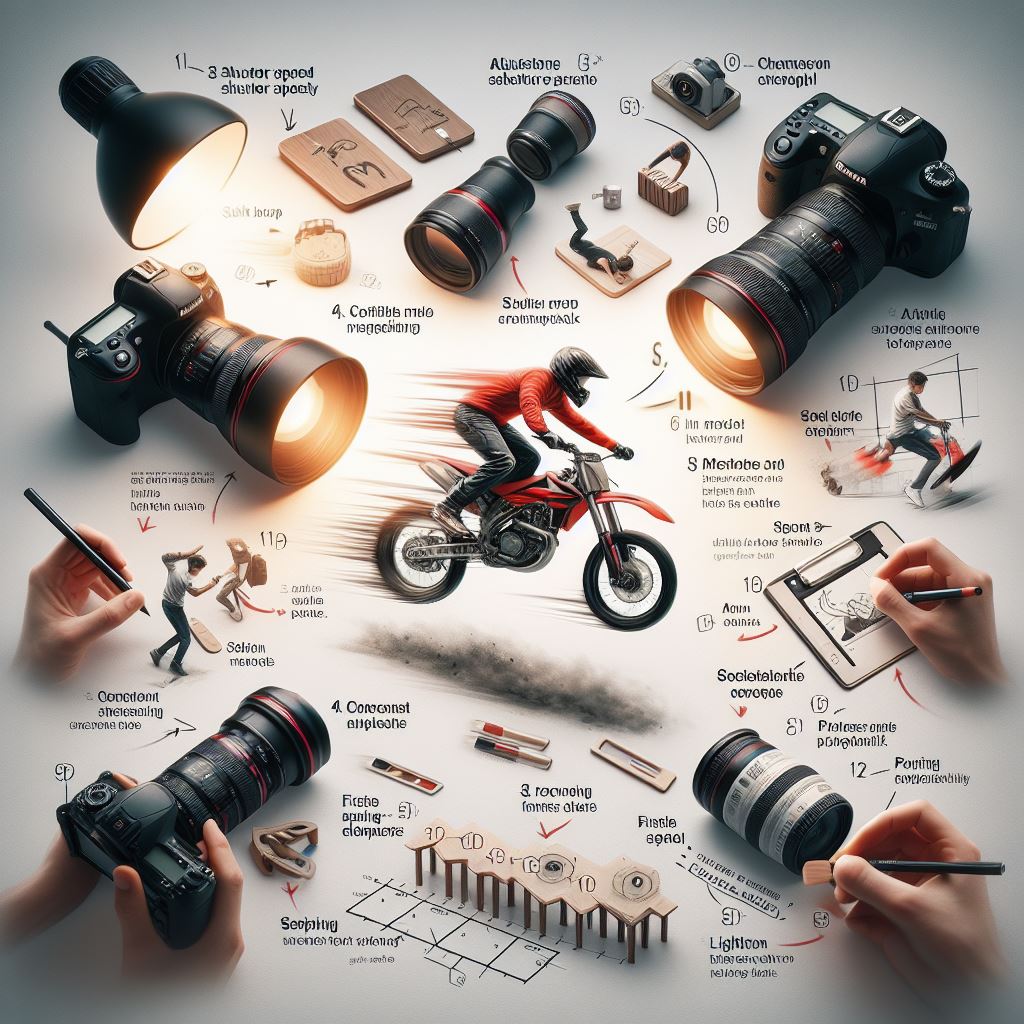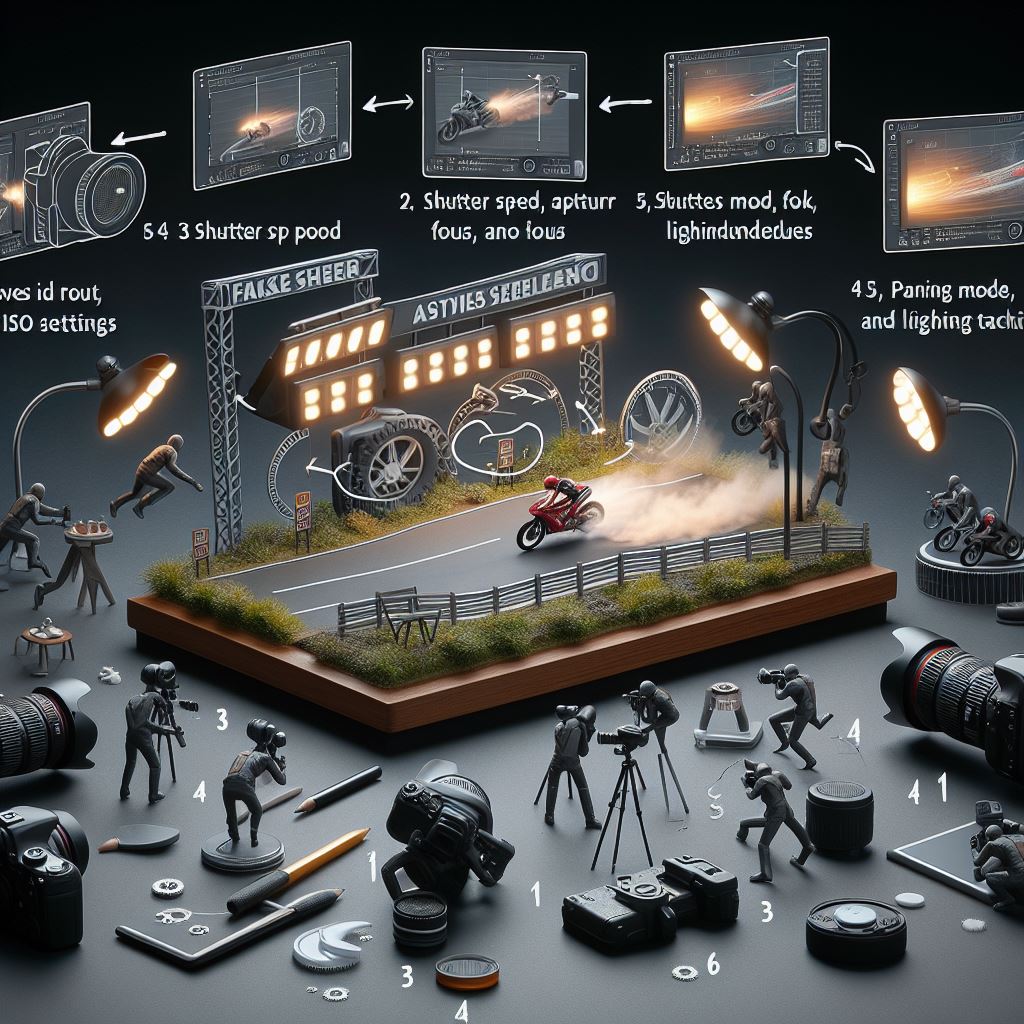Action photography is an exhilarating genre that allows you to freeze moments of intense motion, emotion, and drama. Whether you're capturing athletes in competition, wildlife in motion, or high-speed vehicles, the key to successful action shots lies in a combination of technical skill, creativity, and anticipation.
In this comprehensive guide, we'll share 25 expert tips to help you take your action photography to the next level. We'll cover essential techniques for freezing motion, panning, and anticipating the decisive moment, as well as provide guidance on choosing the right equipment, camera settings, and composition strategies. We'll also explore tips for specific action photography scenarios, such as sports, wildlife, and motorsports.
Choosing the Right Equipment
Having the right equipment is crucial for capturing high-quality action shots. Consider the following when selecting your gear:
Camera Bodies
Choose a camera body with fast autofocus, high burst rates, and good low-light performance. Some popular options for action photography include:
Canon EOS-1D X Mark III
Nikon D6
Sony Alpha a9 II
Fujifilm X-T4
Lenses
Invest in fast, telephoto lenses with wide maximum apertures to isolate your subject and achieve a shallow depth of field. Some recommended lenses for action photography include:
Canon EF 70-200mm f/2.8L IS III USM
Nikon AF-S NIKKOR 400mm f/2.8E FL ED VR
Sony FE 200-600mm f/5.6-6.3 G OSS
Fujifilm XF 100-400mm f/4.5-5.6 R LM OIS WR
Support Systems
Use a sturdy tripod or monopod to stabilize your camera and lens, particularly when using longer focal lengths. Consider a gimbal head for smooth panning and tracking of moving subjects.
Essential Camera Settings

Mastering your camera settings is key to achieving sharp, well-exposed action shots. Here are the essential settings to consider:
Shutter Speed
Use a fast shutter speed (1/500s or faster) to freeze motion and avoid blur. Adjust your shutter speed based on the speed of your subject and the desired effect.
Aperture
Choose a wide aperture (f/2.8-f/4) to allow more light into the camera and achieve a shallow depth of field, isolating your subject from the background.
ISO
Set your ISO based on the available light and desired shutter speed. Higher ISOs may introduce noise but can be necessary for maintaining fast shutter speeds in low-light conditions.
Autofocus Modes
Use continuous autofocus (AI Servo for Canon, AF-C for Nikon) to track moving subjects and ensure sharp focus. Experiment with different AF area modes, such as single-point, zone, or auto-area, depending on the predictability of your subject's movement.
Drive Modes
Set your camera to continuous shooting (burst) mode to capture multiple frames per second and increase your chances of capturing the perfect moment.
Freezing Motion
Freezing fast-moving subjects is a fundamental technique in action photography. Here's how to achieve sharp, frozen action:
Using Fast Shutter Speeds
Use a shutter speed of 1/500s or faster to freeze most action. For extremely fast subjects, like birds in flight or racing cars, you may need to use shutter speeds of 1/1000s or higher.
Continuous Shooting Mode
Set your camera to continuous shooting mode to capture multiple frames per second, increasing your chances of capturing the perfect moment.
Burst Mode
Use your camera's Burst Mode (if available) to capture a rapid sequence of images at the highest possible frame rate. This is particularly useful for unpredictable or fleeting moments of action.
Mastering the Art of Panning
Panning is a technique that involves following a moving subject with your camera, resulting in a sharp subject against a blurred background. Here's how to master the art of panning:
Slow Shutter Speeds
Use a slower shutter speed (1/30s to 1/125s) to create a motion blur effect in the background while keeping your subject sharp.
Smooth Camera Movement
Smoothly track your subject with your camera, keeping it in the same position within the frame. Use a tripod or monopod for stability, and pivot from your waist to maintain a level horizon.
Practicing the Technique
Practice panning on predictable subjects, like cars on a highway or runners on a track, to perfect your technique before attempting more challenging subjects.
Anticipating the Decisive Moment
Anticipating the decisive moment is crucial for capturing compelling action shots. Here's how to develop your timing and intuition:
Studying the Subject
Observe your subject's movements and patterns to predict when the peak action or most visually interesting moment will occur.
Pre-focusing
Pre-focus on a specific spot where you anticipate the action will happen, using manual focus or your camera's AF lock function.
Timing and Patience
Wait for the right moment to unfold, and be prepared to take multiple shots to capture the perfect frame. Patience and persistence are key to achieving standout action shots.
Composition Strategies

Effective composition can take your action shots from ordinary to extraordinary. Consider the following composition techniques:
Rule of Thirds
Place your subject at one of the intersections of the rule of thirds grid to create a balanced, visually appealing composition.
Leading Lines
Use natural lines, such as roads, trails, or barriers, to guide the viewer's eye toward your subject and create a sense of depth and movement.
Negative Space
Include ample negative space in front of your subject to emphasize their direction of movement and create a dynamic composition.
Framing
Use natural elements, such as trees, archways, or bridges, to frame your subject and add depth to your composition.
Unique Angles
Experiment with different angles, such as low or high vantage points, to create more interesting and engaging action shots.
Tips for Sports Photography
Research the sport and familiarize yourself with the rules, key players, and anticipated moments of action.
Choose a fast, telephoto lens (200mm or longer) to capture tight, action-packed shots from a distance.
Position yourself strategically, such as near the finish line, goal posts, or key obstacles, to capture the most dramatic moments.
Use a monopod for added stability and flexibility when tracking fast-moving subjects.
Tips for Wildlife Action Photography
Invest in a long, telephoto lens (400mm or longer) to maintain a safe distance from wildlife while capturing detailed shots.
Research your subject's behavior and habitat to anticipate moments of action, such as hunting, jumping, or fighting.
Use a tripod or beanbag to stabilize your camera and lens, particularly when using longer focal lengths.
Be patient and prepared to wait for the perfect moment, as wildlife can be unpredictable and elusive.
Tips for Motorsports Photography
Choose a location that offers a clear view of the track and anticipate where the most exciting moments of action will occur, such as tight turns or straightaways.
Use a fast shutter speed (1/1000s or faster) to freeze the motion of the vehicles and avoid blur.
Experiment with panning to create a sense of speed and movement, using slower shutter speeds (1/60s to 1/250s) and smooth camera movements.
Protect your gear from dust, debris, and vibrations by using a lens hood, UV filter, and a sturdy tripod or monopod.
Conclusion
Capturing stunning action shots requires a combination of technical skill, creativity, and patience. By choosing the right equipment, mastering your camera settings, and employing techniques like freezing motion, panning, and anticipating the decisive moment, you can elevate your action photography to new heights.
Remember to prioritize composition, experiment with different angles, and adapt your approach to suit your specific subject matter, whether it's sports, wildlife, or motorsports. With practice and persistence, you'll be able to capture the thrill, drama, and emotion of action in your photography.
FAQs
What is the best camera for action photography?
The best camera for action photography is one with fast autofocus, high burst rates, and good low-light performance. Some popular options include the Canon EOS-1D X Mark III, Nikon D6, Sony Alpha a9 II, and Fujifilm X-T4.
What shutter speed should I use for action photography?
For most action shots, a shutter speed of 1/500s or faster is recommended to freeze motion and avoid blur. However, for extremely fast subjects, such as birds in flight or racing cars, you may need to use shutter speeds of 1/1000s or higher.
How do I focus on fast-moving subjects?
Use continuous autofocus (AI Servo for Canon, AF-C for Nikon) to track moving subjects and ensure sharp focus. Experiment with different AF area modes, such as single-point, zone, or auto-area, depending on the predictability of your subject's movement.
What is the best lens for action photography?
The best lens for action photography depends on your specific subject matter. For most action shots, a fast telephoto lens with a wide maximum aperture (such as a 70-200mm f/2.8 or a 400mm f/2.8) is recommended for capturing tight, detailed shots from a distance.
How can I anticipate the decisive moment in action photography?
To anticipate the decisive moment, study your subject's movements and patterns to predict when the peak action or most visually interesting moment will occur. Pre-focus on a specific spot where you anticipate the action will happen, and be prepared to take multiple shots to capture the perfect frame.
Sources and References
- "Action Photography Tips." Digital Photography School, digital-photography-school.com/action-photography-tips/.
- "10 Tips for Improving Your Action Photography." PetaPixel, petapixel.com/2015/06/25/10-tips-for-improving-your-action-photography/.
- "The Ultimate Guide to Sports Photography." Fstoppers, fstoppers.com/education/ultimate-guide-sports-photography-193442.
- "Wildlife Action Photography: Tips for Capturing Stunning Shots." Outdoor Photographer, outdoorphotographer.com/tips-techniques/wildlife-techniques/wildlife-action-photography-tips-for-capturing-stunning-shots/.
- "10 Tips for Better Motorsports Photography." Red Bull, redbull.com/us-en/10-tips-for-better-motorsports-photography.
- "The Art of Panning: How to Master the Technique." PhotoPills, photopills.com/articles/art-panning-how-master-technique.
- "Freezing Action: Using Fast Shutter Speeds for Sharp Photos." Adorama, adorama.com/alc/freezing-action-using-fast-shutter-speeds-for-sharp-photos/.
- "Mastering Autofocus for Action Photography." Canon, canon.com/learn/mastering-autofocus-for-action-photography.
- "The Ultimate Guide to Composition in Action Photography." Photography Life, photographylife.com/composition-action-photography.
- "Capturing the Decisive Moment in Photography." Magnum Photos, magnumphotos.com/theory-and-practice/capturing-the-decisive-moment-in-photography/.
Summary
If you want to take better action shots with your camera, there are a few tips and tricks you can use to get the best results. Using a wide-angle lens and panning can help to exaggerate the effect of the action. The camera's foldable flash can be used to create a technique called “flash and blur”, which combines a slow shutter speed to blur the background while the flash freezes and focuses on the subject. This works best in low light conditions, such as at dawn or dusk.
To create an image with flash and blur, you can either keep the camera steady and take the photo as the action moves in front of the camera, or use the panoramic view to follow the subject while taking the shot. To avoid overexposure, increase your ISO speed if necessary. Burst mode can also help capture the ultimate moment. When composing a shot, use zonal focus to establish an area of sharp focus on the subject.
Multi-pattern measurement is not ideal for taking close-ups of people or animals in action, so using a digital SLR camera is recommended. To achieve a good panoramic shot, use a slightly slower shutter speed and mount your camera on a tripod. Finally, use continuous shooting mode (burst mode) to take multiple photos at once.











